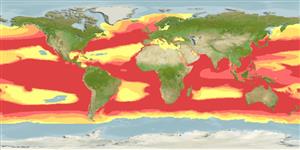Coastal over continental and insular shelves and epipelagic far from land (Ref. 30573, 43278, 58302). Oceanic although most abundant near land, pelagic at 1-366 m (Ref. 58302). Young often close inshore and in shallow bays (Ref. 5578). Feeds on schooling fishes (including mackerels, bluefishes, clupeids, needlefishes, lancetfishes and lanternfishes), squid, octopi, pelagic crustaceans, and rarely seabirds (Ref. 247). Ovoviviparous, embryos feeding on yolk sac and other ova produced by the mother (Ref. 43278, 50449). Uses its long caudal fin to bunch up and stun prey (Ref. 2850). Spatial and depth segregation by sex in northwestern Indian Ocean populations (Ref. 247). A few attacks on boats are doubtfully attributed to this species, but it is otherwise apparently harmless to humans, though the size of adults of this species command respect (Ref. 247). May cause damage to fishing gear (Ref. 6885). Valued for its meat, liver, hide, and fins; utilized fresh, dried-salted, smoked, and frozen (Ref. 9987).
海岸的大陸棚與島嶼棚之上與表層帶遠離土地。 (參考文獻 30573,58302) 大洋性的雖然最豐富的近土地,在 1-366 公尺的大洋性.(參考文獻 58302) 幼魚時常近岸與在淺灣中.(參考文獻 5578) 吃群游性魚 (包括鯖,跳魚,鯡魚,頜針魚,柳葉魚與燈籠魚) ,烏賊,章魚,大洋性甲殼動物, 與很少地海鳥.(參考文獻 247) 卵胎生的, 胚胎吃產生於母親的卵黃囊與其他的卵.(參考文獻 50449) 使用它的長尾鰭串起而且打昏獵物。 (參考文獻 2850) 在在西北部的印度洋族群的性別空間深度分離.(參考文獻 247) 一些對船的攻擊是歸因於可疑的這種,但是否則對人類,它顯然無害處, 雖然這種的成魚的大小值得重視。 (參考文獻 247) 可能引起對漁網的傷害。 (參考文獻 6885) 重要的是它的肉 , 肝臟,隱藏, 與鰭; 生鮮利用 , 乾燥鹽醃,煙燻., 與冷凍.(參考文獻 9987)
Preferred temperature (Ref.
115969): 11.6 - 28.2, mean 23.3 (based on 8352 cells).
Phylogenetic diversity index (Ref.
82804): PD
50 = 0.7500 [Uniqueness, from 0.5 = low to 2.0 = high].
Bayesian length-weight: a=0.00851 (0.00363 - 0.01997), b=2.86 (2.66 - 3.06), in cm Total Length, based on LWR estimates for this species & (Sub)family-body (Ref.
93245).
營養階層 (Ref.
69278): 4.5 ±0.0 se; based on diet studies.
回復力 (Ref.
120179): 低的, 最小族群倍增時間4.5 - 14 年 (K=0.1; tm=5-7; tmax=19; Fec=2-4).
Prior r = 0.05, 95% CL = 0.03 - 0.07, Based on 1 full stock assessment.
Fishing Vulnerability (Ref.
59153): Very high vulnerability (77 of 100).
Climate Vulnerability (Ref.
125649): High vulnerability (62 of 100).
